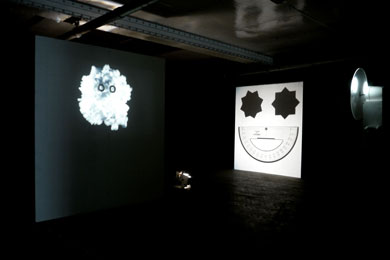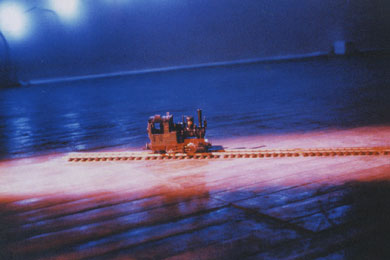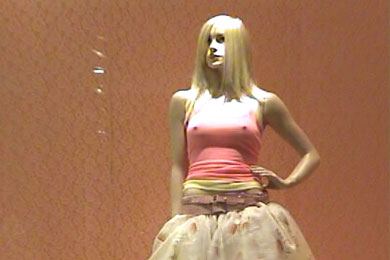
William Cobbing, The Kiss, 2004. Video still courtesy the artist.

Benedict Drew, The Persuaders, 2011. Installation image at James Taylor Gallery, London, courtesy the artist.

Tina Keane, Demolition/Escape, 1983. Image courtesy the artist.

Rachel Lowe, Revolving Woman, 2008. Video still courtesy the artist.
William Cobbing, Demolition, 2004
Excavation, 2004
The Kiss, 2004
William Cobbing is an artist who works across performance, sculpture, video and installation:
Heads feature frequently in these performances but never as faces.
Instead, individual identity is shrouded by a crazed and mucky parallel
of the pixilation that newsroom editors employ in controversial
situations to “protect” the speaker from personal recognition. The
shifting alluvial mask that obscures two heads in The Kiss,
Cobbing’s film of the eponymous action, materialises the look of love
into a tactile mass, a cloggy marl that hands knead, model, smear and
spread noisily, glutinously and messily.
On another occasion he buries a head in a ball of concrete while the
body that owns it stands facing a brick wall, pressed into a column of
the same concrete piled against the elevation. Whether the concrete
originates from the head or from the wall is a detail that Cobbing
leaves to the viewer’s imagination because, having allowed the adhesive
outcrop to dry, the anonymous figure starts picking at the sediment with
a chisel and hammer to bring about his own liberation.
Perhaps this work represents not a nightmare but taps at dream-life
generally, at its incongruities and ludicrousness, those irrational
connections that play out seamlessly in the demented narrative from
which the sleeper awakes momentarily confused and distressed. Head
cases, indeed, and Cobbing’s documentary habit unleashes a sensation
that this whole enterprise has strayed into an art setting through
clinical ancestry.
— Martin Holman, Miser & Now,
‘It shouldn’t happen to a dream’,
Issue 11, 2007, pp. 32-39
Benedict Drew, The Persuaders, 2011
Benedict Drew combines sculpture, moving image and sound
to make
work that explores the expressions and logic of media and its imagery
and operations and the intersections of the physical and digital worlds.
You'll be watched, and in some way controlled.
You might want to resist this, but no matter how, you'll find yourself reacting.
You'll respond to visual and sonic elements that hold a material
form, and you will reciprocate the activity of those technological
devices awaiting you.
Hearing the voices of data streams.
This is a 21st century fable of transition in which the old and the new are just one thing. You'll be told a story about the newness of that which is discarded, and about the physicality of that which is disembodied. You'll enter a place where the obsolete is enhanced and the symbolic meaning becomes animate.
This will be a journey of discovery during which you'll find out about the language of the technological thing; a language that encompasses signs, symbols and signals, and, most of all, embraces the realm of the senses. Deciphering this language means to access the inner world of the device, and perhaps its reasons, in connection to your own world, the outer world.
You'll be interacting with techno-souls, and although you might feel controlled, you might also want to believe in the possibility of a reversal if you succeed in grasping their linguistic codes.
Things consist of tensions, forces, hidden powers, all being constantly exchanged.
This fable might not be a fiction after all, but a story of the 21st century. It might be a story about a journey through the acting technological object and another way to look at its reality: the material form, the being a means to an end which affects but also has many underlying causes. It might not be about enchanted techno-souls, but souls in the sense of manifestations, a display of a series of tensions that are very often disembodied because of our failure to notice.
Excerpt taken from exhibition text by Marialaura Ghidini for The Persuaders at CIRCA Projects, Newcastle upon Tyne, 2011.
Tina Keane, Demolition/Escape, 1983
Tina Keane has been making work exploring moving image technology and
mixed media practice to reveal the operations and poetries of memory and
constructions of gender since the late seventies.
...a large brightly coloured model steam engine...shunts jauntily
back and forth across the floor on a wide-gauge, twelve section track; a
yellow indicator lights up as it moves forward, a red as it reverses.
Behind and to the right of the track is a vertical column of six video
monitors placed alternately right side up and upside down, so that the
screens zigzag upward in a stepwise fashion. The monitors play a
pre-recorded performance of the artist as she crawls along the floor,
grasps a rope ladder and hauls herself up. The zigzagging of the
monitors, the diagonals of the ladder and its shadow snaking across the
screens, and the vertiginous shots of the artist clinging to this flimsy
structure combine to create a queasy feeling of suspense and
instability. The third part of the installation, which completes a three
dimensional triangle, is a line of blue neon numbers from nine to one
(a sliding scale or countdown), which diagonally ascends the wall from
behind and the left of the track. The blue haze of the neon and the red
light of the train are reflected by the blue and red hues of the video
performance, a painterly use of colour and different light qualities
which endows the work's sculptural physicality with physical presence.
— Jean Fisher, Demolition/Escape, Art Forum, May 1983
Demolition/Escape (1983) is presented with the generous support of LUX - Artists' Moving Image, London.
Rachel Lowe, Revolving Woman, 2008
Rachel Lowe's practice engages with the physicality of the moving image,
looking at the building blocks of trace and memory. She presents the
works in such a way that the viewer is made acutely aware of constituent
operations of the image that they perceive, how it is generated by a
series of pulses of light in a matrix of darkness that leave ghosts upon
the retina so that a series of images combine to generate the
simulacrum of movement.
Her video installation Revolving Woman uses footage of a mannequin the artist shot on analogue video tape in a shopping mall in Brazil. The grainy recording of the figure's slow rotation in space in an echoing bubble of ambient sound is interrupted and choreographed with the interjection of geometric forms, hard-edged on the picture plane of the screen. These flash up almost too fast for the eye to easily register and exist as much as a startled memory as immediate perception, so producing a complex choreography of flicker, of light and darkness, the occasional flash of colour in time, and a tension between the illusionistic depth of the photographic registration of the figure and the flatness of the wall upon which the image is projected, returning us to an engagement with the elemental constituents of the projected image.